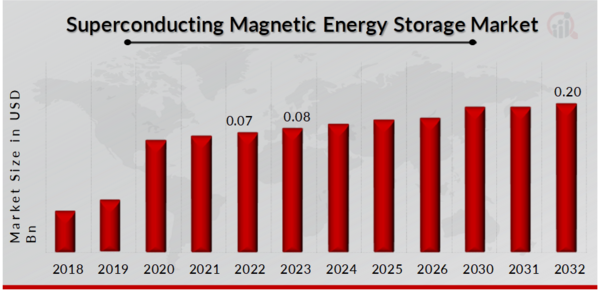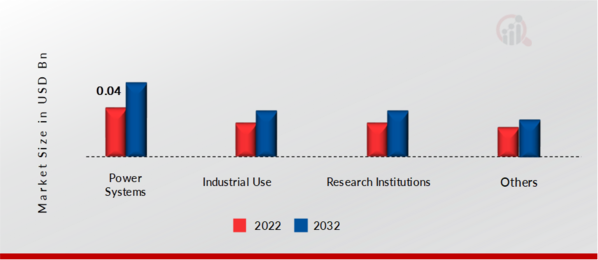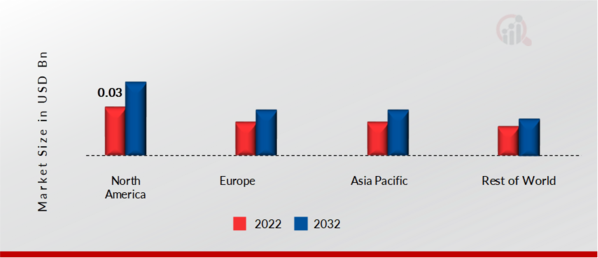Global Superconducting Magnetic Energy Storage Market Overview:
Superconducting Magnetic Energy Storage Market Size was valued at USD 0.07 Billion in 2022. The Superconducting Magnetic Energy Storage Market industry is projected to grow from USD 0.08 Billion in 2023 to USD 0.20 Billion by 2032, exhibiting a compound annual growth rate (CAGR) of 12.50% during the forecast period (2023 - 2032). Rising demands for grid stability and the increasing integration of renewable energy sources are expected to be significant market drivers for the superconducting magnetic energy storage market.

Source: Secondary Research, Primary Research, MRFR Database and Analyst Review
Superconducting Magnetic Energy Storage Market Trends
-
Adoption of advanced energy storage solutions, such as superconducting magnetic energy storage (SMES) is driving the market growth
Market CAGR for superconducting magnetic energy storage is being driven by the adoption of advanced energy storage solutions, such as Superconducting Magnetic Energy Storage (SMES). As the demand for uninterrupted power supply becomes integral across various sectors, energy storage solutions are increasingly sought after to meet the rising energy needs. Superconducting Magnetic Energy Storage (SMES) systems, a cutting-edge technology, store electrical energy as magnetic energy for on-demand utilization.
In June 2023, Agratas Energy Storage Solutions Private Limited, a subsidiary of Tata Group, inked an agreement with the Gujarat government to establish India's inaugural gigafactory for Lithium-Ion batteries, with an initial investment of USD 1.57 billion for a 20-gigawatt unit. Meanwhile, Tata Power Solar Systems Limited secured a solar plus storage project from Solar Energy Corporation of India Ltd (SECI) in Chattisgarh, involving EPC services for a 100 MW solar power plant and a 120 MWh capacity Battery Energy Storage System (BESS), with a project outlay of approximately USD 115 million. The project is slated for commissioning in the second half of 2023.
SMES systems capitalize on the zero-resistance phenomenon, storing electricity by creating a magnetic field around the superconducting device operating below its critical temperature. The elements within the SMES systems are cooled to temperatures below their critical threshold to achieve superconductivity. Offering swift response times to load fluctuations and frequency changes, these systems mitigate challenges associated with lead-acid battery recycling. These factors are poised to drive growth in the Superconducting Magnetic Energy Storage Market throughout the forecast period. As a result, it is anticipated that throughout the projection period, demand for the Superconducting Magnetic Energy Storage Market will increase due to the adoption of advanced energy storage solutions, such as Superconducting Magnetic Energy Storage (SMES). Thus, driving the Superconducting Magnetic Energy Storage Market revenue.
Superconducting Magnetic Energy Storage Market Segment Insights:
Superconducting Magnetic Energy Storage Market Type Insights
The Superconducting Magnetic Energy Storage Market segmentation, based on Type includes Low-Temperature and high-temperature. The low-temperature segment dominated the market, accounting for 58% of market revenue (0.04 Billion). Superconductors intended to operate at lower temperatures are typically classified as low-temperature superconductors. This is frequently accomplished by using liquid helium or other cryogenic cooling methods. The development of superconducting materials that function better at lower temperatures is expected to propel this industry's growth.
Superconducting Magnetic Energy Storage Market Application Insights
The Superconducting Magnetic Energy Storage Market segmentation, based on End-User includes Power Systems, Industrial Use, Research Institutions, and Others. The power systems segment dominated the market, accounting for 58% of market revenue (0.04 Billion). As renewable energy sources like solar and wind become more integrated into power systems, there arises a demand for energy storage solutions to address the intermittency and variability associated with these sources. Within the Power Systems segment, SMEs can play a crucial role by storing surplus energy during periods of high renewable generation and releasing it during peak demand or when renewable output is low.
Figure 1: Superconducting Magnetic Energy Storage Market, by Application, 2022 & 2032 (USD Billion)

Source: Secondary Research, Primary Research, MRFR Database and Analyst Review
Superconducting Magnetic Energy Storage Market Regional Insights
By region, the study provides market insights into North America, Europe, Asia-Pacific, and Rest of the World. The anticipated expansion of the Superconducting Magnetic Energy Storage market in North America can be attributed to several key factors. The United States has witnessed a substantial uptick in the adoption of renewable energy sources, particularly wind and solar. Renewable energy, the fastest-growing energy sector in the country, experienced a remarkable 42 percent increase from 2010 to 2020, marking a substantial 90 percent surge from 2000 to 2020.
In 2020, renewables accounted for nearly 20 percent of utility-scale electricity generation, predominantly sourced from hydropower (7.3 percent) and wind power (8.4 percent). Recognizing the intermittent nature of these renewables, Superconducting Magnetic Energy Storage (SMES) systems present a strategic solution by efficiently storing surplus energy during peak production periods and releasing it during periods of high demand or when renewable output is diminished.
Further, the major countries studied in the market report are the US, Canada, Germany, France, the UK, Italy, Spain, China, Japan, India, Australia, South Korea, and Brazil.
Figure 2: Superconducting Magnetic Energy Storage Market Share By Region 2022 (USD Billion)

Source: Secondary Research, Primary Research, MRFR Database and Analyst Review
Europe's Superconducting Magnetic Energy Storage Market accounts for the second-largest market share as Governments and institutions in Europe frequently allocate substantial funds to support initiatives in the clean energy and energy storage sectors. According to the latest data from the IEA's Government Energy Spending Tracker, the cumulative investment in clean energy projects by governments has surged to USD 1.34 trillion since 2020.
A significant portion of these funds, approximately USD 90 billion, is dedicated to direct incentives for manufacturers, strategically designed to bolster domestic production of clean energy technologies. The provision of subsidies, grants, and incentives specifically tailored for the development and deployment of Superconducting Magnetic Energy Storage (SMES) systems can serve as a catalyst, fostering market growth and rendering these technologies economically viable. Further, the German Superconducting Magnetic Energy Storage Market held the largest market share, and the UK Superconducting Magnetic Energy Storage Market was the fastest-growing market in the European region
The Asia-Pacific Superconducting Magnetic Energy Storage Market is expected to grow at the fastest CAGR from 2023 to 2032. The Asia Pacific region, characterized by rapid industrialization and urbanization, has witnessed a substantial surge in energy demand, with primary energy consumption experiencing a notable 10% annual increase, reaching 35 EJ from 32 EJ. Notably, coal holds a significant share of 57% of the region's primary energy, contrasting with the global average of 24%. India, contributing 12.5% to global coal consumption, plays a substantial role.
In this dynamic energy landscape, businesses operating in the region are confronted with the dual challenge of meeting escalating energy demands and aligning with cleaner energy trends. This necessitates the adoption of advanced energy storage solutions, notably Superconducting Magnetic Energy Storage (SMES), to effectively manage the transition towards cleaner and more sustainable energy sources while ensuring reliability and efficiency in meeting heightened energy needs. Moreover, China’s Superconducting Magnetic Energy Storage Market held the largest market share, and the Indian Superconducting Magnetic Energy Storage Market was the fastest-growing market in the Asia-Pacific region.
Superconducting Magnetic Energy Storage Market Key Market Players & Competitive Insights
Leading market players are investing heavily in research and development to expand their product lines, which will help the Superconducting Magnetic Energy Storage market, grow even more. Market participants are also undertaking a variety of strategic activities to expand their global footprint, with important market developments including new product launches, contractual agreements, mergers and acquisitions, higher investments, and collaboration with other organizations. To expand and survive in a more competitive and rising market climate, the Superconducting Magnetic Energy Storage industry must offer cost-effective items.
Manufacturing locally to minimize operational costs is one of the key business tactics used by manufacturers in the global Superconducting Magnetic Energy Storage industry to benefit clients and increase the market sector. In recent years, the Superconducting Magnetic Energy Storage industry has offered some of the most significant advantages to the energy storage sector, providing innovative solutions for grid stability, rapid energy response, and efficient integration of renewable energy. Major players in the Superconducting Magnetic Energy Storage Market, including AMSC, Bruker Energy & Supercon Technologies, Fujikura Automotive America, LLC., Southwire Company, Nexans, Columbus superconductors, Sumitomo Electric Group Indonesia, ASG Superconductors S.p.A., ABB, Superconductor Technologies are attempting to increase market demand by investing in research and development operations.
American Superconductor Corp (AMSC) is a prominent energy technology firm specializing in the design and manufacturing of power systems and superconductor wires. Additionally, the company provides engineering planning services, advanced grid systems, and electronic controls for wind turbines. AMSC caters to electric utilities, industrial facilities, and renewable energy project developers, facilitating the transmission and distribution of electricity through its power electronics, superconductor-based systems, and transmission planning services. With a global presence spanning North America, Europe, Asia Pacific, and Africa, AMSC operates sales and field service offices strategically located in key markets, including China, Germany, India, Australia, Korea, Jordan, and the UK. The company is headquartered in Ayer, Massachusetts, USA.
Southwire Company LLC is a prominent player in the electricity equipment sector, specializing in the manufacturing of wire and cable designed for the distribution and transmission of electricity. The company's extensive product portfolio includes building wire and cable, metal-clad cable, overhead and underground transmission and distribution wire and cable products, original equipment manufacturer (OEM) wire products, portable and electronic cord products, and engineered products.
In addition to its diverse range of products, Southwire also provides contractor equipment, hand tools, and assembled products and components. Southwire caters to a wide array of industries, including transmission, renewables, hospitals and healthcare, residential, refining, factory automation, power distribution, and transportation. The company's offerings play a crucial role in supporting various sectors, contributing to the efficiency and reliability of electrical systems. Headquartered in Carrollton, Georgia, USA, Southwire is strategically positioned to serve its clientele with innovative and high-quality solutions in the electricity equipment market.
Key companies in the Superconducting Magnetic Energy Storage Market include
- AMSC
- Bruker Energy & Supercon Technologies
- Fujikura Automotive America, LLC.
- Southwire Company
- Nexans
- Columbus superconductors
- Sumitomo Electric Group Indonesia
- ASG Superconductors S.p.A.
- ABB
- Superconductor Technologies
Superconducting Magnetic Energy Storage Industry Developments
October 2017:In 2017, China unveiled plans to expand its large-scale energy storage capacity by leveraging renewable energy sources. As these initiatives progress, the government will initiate pilot projects to evaluate energy storage technologies, incorporating superconducting magnetic energy storage alongside lead-acid and lithium-ion batteries.
November 2018:In November 2018, Ecoswing announced the deployment of a superconducting drive chain generator on an existing large-scale wind turbine in Denmark, replacing the conventional permanent magnet generator. This marks a significant milestone as it represents the first installation of a superconducting generator by the organization, with Envision as a partner in the project, receiving support from the European Commission.
Superconducting Magnetic Energy Storage Market Segmentation:
Superconducting Magnetic Energy Storage Market Type Outlook
- Low-Temperature
- High-temperature
Superconducting Magnetic Energy Storage Market Application Outlook
- Power Systems
- Industrial Use
- Research Institutions
- Others
Superconducting Magnetic Energy Storage Market Regional Outlook
- North America
- Europe
- Germany
- France
- UK
- Italy
- Spain
- Rest of Europe
- Asia-Pacific
- China
- Japan
- India
- Australia
- South Korea
- Australia
- Rest of Asia-Pacific
- Rest of the World
- Middle East
- Africa
- Latin America
| Report Attribute/Metric |
Details |
| Market Size 2022 |
USD 0.07 Billion |
| Market Size 2023 |
USD 0.08 Billion |
| Market Size 2032 |
USD 0.20 Billion |
| Compound Annual Growth Rate (CAGR) |
12.50% (2023-2032) |
| Base Year |
2022 |
| Market Forecast Period |
2023-2032 |
| Historical Data |
2018- 2022 |
| Market Forecast Units |
Value (USD Billion) |
| Report Coverage |
Revenue Forecast, Market Competitive Landscape, Growth Factors, and Trends |
| Segments Covered |
Type, Application, and Region |
| Geographies Covered |
North America, Europe, Asia Pacific, and the Rest of the World |
| Countries Covered |
The US, Canada, Germany, France, UK, Italy, Spain, China, Japan, India, Australia, South Korea, and Brazil |
| Key Companies Profiled |
AMSC, Bruker Energy & Supercon Technologies, Fujikura Automotive America, LLC., Southwire Company, Nexans, Columbus superconductors, Sumitomo Electric Group Indonesia, ASG Superconductors S.p.A., ABB, Superconductor Technologies |
| Key Market Opportunities |
Government initiatives and policies aimed at promoting clean energy and grid modernization |
| Key Market Dynamics |
Increasing Demand for Power |
Superconducting Magnetic Energy Storage Market Highlights:
Frequently Asked Questions (FAQ) :
The Superconducting Magnetic Energy Storage Market size was valued at USD 0.07 Billion in 2022.
The Superconducting Magnetic Energy Storage Market is projected to grow at a CAGR of 12.50% during the forecast period, 2023-2032.
North America had the largest share of the global market
The key players in the market are AMSC, Bruker Energy & Supercon Technologies, Fujikura Automotive America, LLC., Southwire Company, Nexans, Columbus Superconductors, Sumitomo Electric Group Indonesia, ASG Superconductors S.p.A., ABB, Superconductor Technologies
The Low-Temperature segment dominated the market in 2022.
The Power Systems segment had the largest share in the global market.

















